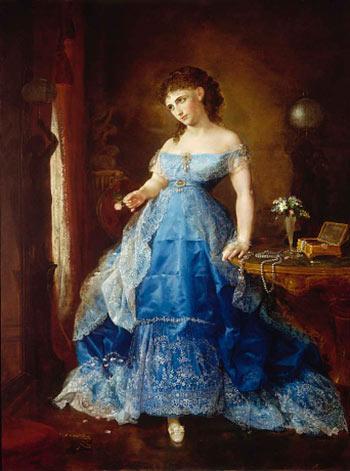Erin Benz interned at American Art's Luce Foundation Center this summer. While here, she took the time to write about one of her favorite artists in our collection, Lilly Martin Spencer.

Lilly Martin Spencer's We Both Must Fade (Mrs. Fithian)
I first became interested in the painter, Lilly Martin Spencer, when I learned about her in my sophomore art history class. Amongst the many mid-nineteenth century male artists who we were learning about Spencer was one of the only female artists we studied. Immediately, I became intrigued as to how a woman was able to succeed in a predominately male field while being a mother and wife at the same time. Her paintings also interested me as they were beautifully detailed, yet frequently included a comical aspect which, combined, made viewing her paintings fun. Spencer's painting, We Both Must Fade (Mrs. Fithian) is on display here at American Art and always catches my eye when I wander past it. The beautiful fabric and exquisite details make me stop and take in this painting's magnificence.
Lilly Martin Spencer was born in England in 1822 and immigrated to the United States ten years later. Spencer was unique as she was a female painter who lived off of her work and was the sole provider for her family. Her husband, Benjamin Spencer, did not have a job and mainly helped his wife as a business manager. In order to make a living off of her paintings, Spencer decided to paint popular genre scenes that would sell better than her previous allegorical paintings. By taking her everyday experiences from home, she was able to move from her old subject matter to her new. With thirteen children, Spencer had to balance making a living and being a mother at a time when women's jobs were clearly domestic while their husbands worked. Though genre painting eventually fell out of fashion, Spencer is still considered one of America's greatest genre painters.
See! From those priceless jewels in her bower,
The queenly Beauty turns her neck away,
And Eyes that pale not 'neath the diamond's ray,
Muse in their loveliness on one sweet flower—
Whose bloom alas! Has reach'd its fated hour.
Thomas C. Latto
Exhibition Label, Smithsonian American Art Museum, 2006
Spencer's 1869 painting, We Both Must Fade (Mrs. Fithian), can be seen on the second floor of the museum. In it, Spencer depicts a beautiful young woman surrounded by jewels and clothed in layers of expensive blue fabric. Great detail is given to the design of the dress and, at 6 feet tall, commands the viewer's attention while showing off Spencer's great skill. Though the subject appears to be wealthy and have many suitors (as the jewels appear to suggest), Spencer implies that her beauty is only temporary and will eventually disappear. As the flower is her hand wilts, she too will eventually succumb to life's ultimate price: time.

